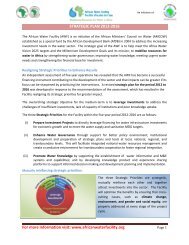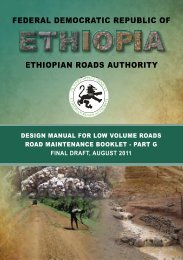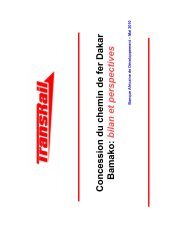Design-Manual-for-Low-Volume-Roads-Part-A
Design-Manual-for-Low-Volume-Roads-Part-A
Design-Manual-for-Low-Volume-Roads-Part-A
You also want an ePaper? Increase the reach of your titles
YUMPU automatically turns print PDFs into web optimized ePapers that Google loves.
A - Chapter 1 - 7<br />
The role of the design engineer is to recognise and design to these parameters and optimise the design<br />
to the expected per<strong>for</strong>mance. This is known as an environmentally optimised design (EOD) approach.<br />
EOD takes account of road environment changes along the alignment and the design responds to these<br />
changes (<strong>for</strong> more details see <strong>Part</strong> D, Section 6.13).<br />
1.5 Surface improvement technology<br />
Gravel and earth roads are particularly vulnerable to the effects of the road environment. A range of more<br />
durable surfacing options, other than gravel or earth are available <strong>for</strong> low volume roads. These include<br />
thin bituminous surfacings, and non-bituminous surfacings such as cobbles, hand packed stone and even<br />
thin concrete. The selection, design and use of the various surfacing options are described in detail in<br />
this manual in <strong>Part</strong> D, Chapter 7 with design standards presented in <strong>Part</strong> B, Chapter 3.4.<br />
Improved surfacings may be provided <strong>for</strong> the entire length of a road, or only on the most vulnerable<br />
sections. The approach may include dealing only with individual critical sections (weak or vulnerable<br />
sections; roads through villages or settlements) on a road link (spot improvements), or providing a total<br />
whole rural link design, which could comprise different design options along its length.<br />
The choice of surfacing type, and when to use it, involves a trade-off between initial cost, level of service<br />
and maintenance requirements. Cobblestone may use locally available resources and require very little<br />
maintenance, but it gives a relatively rough riding surface. Surface dressings provide smoother riding<br />
surfaces but may require more expensive earthworks and pavement layers, as well as imported bitumen,<br />
specialised equipment and skilled operators. Appropriate selection will be driven to some extent by the<br />
service level.<br />
Surface dressings should not be constructed where there is no capacity <strong>for</strong> routine maintenance, including<br />
pothole repairs and crack sealing, as well as periodic re-sealing. Edge break is a common problem on<br />
sealed roads due to vehicles and pedestrians moving on and off the road, and needs to be controlled<br />
through appropriate road width, provision of stopping places, and kerbing.<br />
The challenge <strong>for</strong> the design engineer <strong>for</strong> a low volume road is to achieve the required level of service,<br />
using appropriate engineering approaches and to minimise costs over the whole life of the road. This<br />
should be done in a context sensitive way that recognises the needs of the client, the road environment<br />
and the prevailing maintenance management regime.<br />
1.6 Context sensitivity<br />
In addition to ensuring that the design developed is technically appropriate and is within the financial<br />
envelope, the design engineer needs to bear in mind other factors that could influence the success of the<br />
low volume road design approach, its implementation and its long term sustainability.<br />
This requires a broadly focused, multi-dimensional and context sensitive approach in which a number of<br />
other influential factors are considered, illustrated in Figure A.1.3.<br />
1.6.1 Political support<br />
Demand <strong>for</strong> low volume road provision needs to be framed under a national policy driven by government<br />
and should be supported at the highest level. The cross-sectoral influence of low volume road provision<br />
and its role in under-pinning other sectoral development strategies and poverty alleviation programmes<br />
should be highlighted, quantified and understood.<br />
The approach adopted <strong>for</strong> low volume road provision should complement national plans, policies and<br />
strategies and should be responsive to wider needs and demands, including:<br />
• The social and economic goals of poverty alleviation and development;<br />
• Increasing rural accessibility;<br />
• The use of appropriate technology, promotion of the domestic construction industry and<br />
employment creation;<br />
• Protection of the environment;<br />
• Cost minimisation and improved efficiency.<br />
PART A: DESIGN STANDARD APPROACHES

















